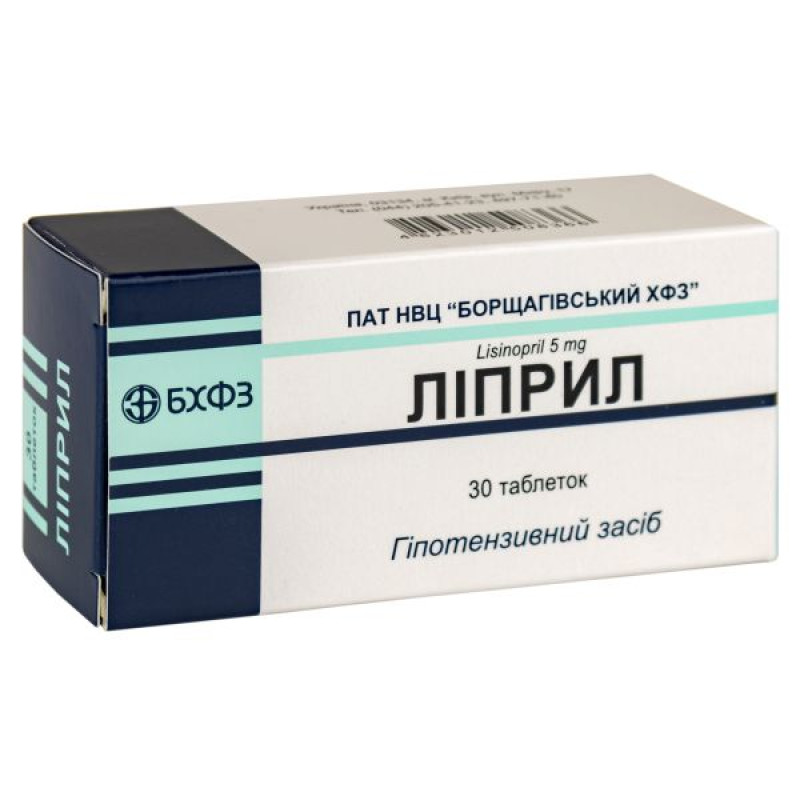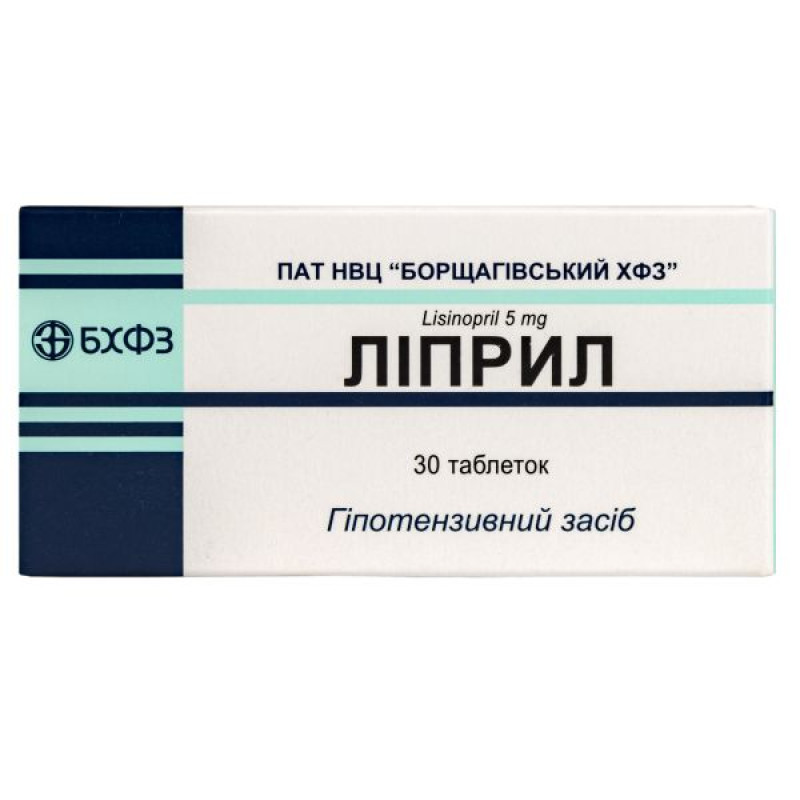Lipril tablets 5 mg blister No. 30

"Lipril" tablets are used for the following indications:
essential hypertension; heart failure (symptomatic treatment); acute myocardial infarction (short-term treatment (6 weeks) of patients with stable hemodynamic parameters no later than 24 hours after acute myocardial infarction); treatment of initial nephropathy in patients with type 2 diabetes mellitus with arterial hypertension.Composition
The active substance is lisinopril (one tablet contains lisinopril (calculated as 100% anhydrous lisinopril) 5 mg, which corresponds to lisinopril dihydrate - 5.44 mg).
Excipients: mannitol (E 421), calcium hydrogen phosphate dihydrate, corn starch, magnesium stearate.
Contraindication
Hypersensitivity to lisinopril, to any of the excipients or to other ACE inhibitors; history of angioedema after taking ACE inhibitors; idiopathic or hereditary angioedema; bilateral renal artery stenosis or stenosis of the artery to a solitary kidney; kidney transplantation; mitral or aortic stenosis, hypertrophic cardiomyopathy with severe hemodynamic compromise; acute myocardial infarction with unstable hemodynamics; cardiogenic shock; use of high-flux membranes with polyacrylonitrile sodium-2-methylallylsulfonate (e.g. AN 69) in dialysis; use with aliskiren-containing drugs, diabetes mellitus or impaired renal function (GFR <60 ml/minute/1.73 m2); serum creatinine level >220 μmol/l; primary hyperaldosteronism; pregnant women or women planning to become pregnant.Method of application
The drug should be taken once a day in the morning, preferably at the same time, with plenty of water. "Lipril" can be used regardless of meals.
The dose and course of treatment are determined by the doctor individually depending on the severity of the disease, the state of kidney function and concomitant therapy.
Essential hypertension
Lisinopril can be used as monotherapy or in combination with other antihypertensive drugs.
Initial dose. The recommended initial dose is 10 mg per day. In patients with an overactive renin-angiotensin-aldosterone system (in particular, with renovascular hypertension, increased electrolyte depletion and/or dehydration, cardiac decompensation or severe arterial hypertension), an excessive decrease in blood pressure may occur after taking the initial dose. Therefore, at the beginning of treatment, such patients should be under medical supervision, the recommended initial dose is 2.5-5 mg.
Maintenance dose. The usual effective maintenance dose is 20 mg once daily. If the desired therapeutic effect is not achieved after 2-4 weeks of use of the prescribed dose, the dose may be increased. The maximum daily dose should not exceed 80 mg.
Heart failure
In patients with symptomatic heart failure, lisinopril can be used as an adjunct to therapy with diuretics, digitalis, or β-blockers.
The initial dose, which should be taken under medical supervision to determine the initial effect on blood pressure, is 2.5 mg per day. The dose of the drug should be increased by no more than 10 mg, at intervals of at least 2 weeks and up to a maximum dose of 35 mg per day.
When adjusting the dose, the clinical response of the individual patient should be taken into account.
In patients at high risk of developing symptomatic hypotension (e.g. those with electrolyte depletion with or without hyponatremia, hypovolemia, or those receiving intensive diuretic therapy), the above conditions should be corrected before starting treatment. Treatment with lisinopril should be carried out under the control of renal function and serum potassium levels.
Acute myocardial infarction
Patients should receive concomitant standard therapy with thrombolytic drugs, acetylsalicylic acid, and β-blockers. Lisinopril is compatible with intravenous or transdermal nitroglycerin.
Lisinopril therapy should be started within 24 hours of the onset of symptoms of myocardial infarction according to the following scheme: the initial dose is 5 mg, the next dose (after 24 hours) is 5 mg, then (after 48 hours) is 10 mg. Then the maintenance dose is 10 mg per day. Patients with low systolic blood pressure (120 mm Hg or lower) should be prescribed 2.5 mg at the beginning of treatment or in the first 3 days after myocardial infarction.
The maintenance dose is 10 mg once daily. If hypotension occurs (systolic blood pressure less than or equal to 100 mm Hg), the maintenance dose of 5 mg should be temporarily reduced to 2.5 mg. If prolonged hypotension occurs (systolic blood pressure less than 90 mm Hg for more than one hour), treatment should be discontinued.
The duration of treatment is 6 weeks, after which the patient's condition must be re-evaluated. The appearance of symptoms of heart failure does not exclude further use of the drug.
Nephropathy in diabetes mellitus
In the treatment of hypertension in patients with type 2 diabetes mellitus and initial nephropathy, the dose of the drug is 10 mg once a day. If necessary, the dose can be increased to 20 mg per day to achieve diastolic blood pressure below 90 mm Hg in the sitting position.
Application features
ACE inhibitor drugs are contraindicated for use in pregnant women or women planning to become pregnant.
Because no information is available regarding the use of lisinopril during breastfeeding, lisinopril is not recommended for use in nursing mothers. Alternative antihypertensive treatments with better established safety profiles during breastfeeding are preferable, especially while nursing a newborn or preterm infant.
Children
The effectiveness and safety of lisinopril in children have not been established, so the drug should not be used in this age group.
Drivers
During treatment with the drug, adverse reactions from the nervous system (dizziness, confusion, drowsiness) may occur, especially at the beginning of treatment, therefore, when using the drug, you should refrain from driving or using other mechanisms until your individual reaction to the drug is established.
Overdose
Symptoms: hypotension, circulatory shock, fluid and electrolyte imbalance, renal failure, hyperventilation, tachycardia, palpitations, bradycardia, dizziness, restlessness and cough.
Treatment: symptomatic, intravenous administration of saline is recommended. In case of hypotension, the patient should be placed in bed (legs should be raised). Angiotensin II infusion and/or intravenous administration of catecholamines are possible. If the drug was taken recently, then induction of vomiting, gastric lavage, administration of enterosorbents and sodium sulfate are recommended for its removal. Lisinopril can be removed from the body by hemodialysis, while the use of polyacrylonitrile metal sulfonate high-flux membranes (for example, AN 69) should be avoided.
Side effects
Blood and lymphatic system: decreased hemoglobin and hematocrit levels, bone marrow suppression, anemia, thrombocytopenia, leukopenia, neutropenia, agranulocytosis, hemolytic anemia, lymphadenopathy, autoimmune diseases.
Nervous system: dizziness, headache, mood changes, paresthesia, vertigo, taste disturbances, sleep disturbances, confusion, smell disturbances, balance disorders, disorientation, tinnitus, decreased visual acuity, symptoms of depression, syncope, hallucinations.
Cardiovascular system: hypotension (especially after the first dose of the drug in patients with sodium deficiency, dehydration, heart failure), orthostatic effects (including hypotension), myocardial infarction or cerebrovascular stroke, possibly secondary to excessive hypotension in high-risk patients; palpitations, tachycardia, Raynaud's phenomenon. When using lisinopril in patients with acute myocardial infarction, second- and third-degree AV block, severe hypotension and/or impaired renal function, and in rare cases, cardiogenic shock are possible, especially in the first 24 hours.
Musculoskeletal system: muscle spasms have been reported.
Respiratory, thoracic and mediastinal disorders: cough, rhinitis, bronchitis, dyspnoea, bronchospasm, sinusitis, allergic alveolitis/eosinophilic pneumonia. Upper respiratory tract infections have been reported.
Digestive tract and hepatobiliary system: diarrhea, constipation, vomiting, nausea, abdominal pain, dyspepsia, dry mouth, glossitis, decreased appetite, pancreatitis, intestinal angioedema, hepatocellular or cholestatic hepatitis, jaundice, liver failure.
Skin and subcutaneous tissue: rash, pruritus, urticaria, alopecia, psoriasis, hypersensitivity reactions/angioedema: angioedema of the face, extremities, lips, tongue, vocal cords and/or larynx, hyperhidrosis, pemphigus, toxic epidermal necrolysis, Stevens-Johnson syndrome, erythema multiforme, pseudolymphoma of the skin.
A complex reaction has been reported, including one or more of the following symptoms: fever, vasculitis, myalgia, arthralgia/arthritis, positive antinuclear antibody test, increased erythrocyte sedimentation rate (ESR), eosinophilia and leukocytosis, rash, photosensitivity reactions or other dermatological manifestations.
Human anatomical models: renal dysfunction, uremia, acute renal failure, oliguria/anuria.
Endocrine system: inappropriate secretion of antidiuretic hormone.
Reproductive system and mammary glands: impotence, gynecomastia.
Metabolic disorders: hypoglycemia, gout.
Storage conditions
Store in the original packaging at a temperature not exceeding 25 °C, out of the reach of children.
Shelf life - 3 years.
There are no reviews for this product.
There are no reviews for this product, be the first to leave your review.
No questions about this product, be the first and ask your question.









